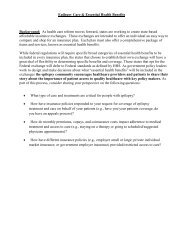Legal Rights of Children with Epilepsy in School & Child Care
Legal Rights of Children with Epilepsy in School & Child Care
Legal Rights of Children with Epilepsy in School & Child Care
You also want an ePaper? Increase the reach of your titles
YUMPU automatically turns print PDFs into web optimized ePapers that Google loves.
<strong>Legal</strong> <strong>Rights</strong> <strong>of</strong> <strong><strong>Child</strong>ren</strong> <strong>with</strong> <strong>Epilepsy</strong> <strong>in</strong> <strong>School</strong> and <strong>Child</strong> <strong>Care</strong><br />
Many states have statutes, regulations, or policies govern<strong>in</strong>g the use <strong>of</strong> restra<strong>in</strong>ts<br />
and seclusion <strong>in</strong> schools. Attorneys and advocates should familiarize themselves<br />
<strong>with</strong> any available law. Additionally, many states prohibit the use <strong>of</strong> corporal<br />
punishment. Arguably, the use <strong>of</strong> restra<strong>in</strong>t <strong>with</strong> a student, particularly a student<br />
<strong>with</strong> a disability, might constitute corporal punishment.<br />
6.3Q:<br />
May school staff use a leash <strong>with</strong> a child <strong>with</strong> epilepsy on community<br />
out<strong>in</strong>gs for safety or for any other reason? 44<br />
A: The IDEA does not prohibit the use <strong>of</strong> a leash, but it is a degrad<strong>in</strong>g practice, and<br />
it is difficult to imag<strong>in</strong>e how it could possibly help keep a student <strong>with</strong> epilepsy<br />
safe. Presumably, staff believe that somehow they can prevent a student from<br />
fall<strong>in</strong>g to the ground dur<strong>in</strong>g a seizure if the student is leashed, but unless staff<br />
can produce peer-reviewed research to support this assertion, parents should not<br />
agree to the use <strong>of</strong> a leash. <strong>School</strong> staff should consult <strong>with</strong> the student’s parents<br />
and his or her physicians to determ<strong>in</strong>e the most appropriate and least <strong>in</strong>trusive<br />
means <strong>of</strong> ensur<strong>in</strong>g the student’s safety <strong>in</strong> the community.<br />
6.4Q:<br />
Must a school adm<strong>in</strong>ister antiepileptic medication to a student <strong>with</strong> epilepsy<br />
dur<strong>in</strong>g the school day?<br />
A: Yes, a school must adm<strong>in</strong>ister antiepileptic medication to a student <strong>with</strong> epilepsy<br />
dur<strong>in</strong>g the school day if he or she has a doctor’s order and needs the medication<br />
dur<strong>in</strong>g the school day <strong>in</strong> order to be able to attend school and benefit from his or<br />
her education. Medication adm<strong>in</strong>istration is a “school health service,” a related<br />
service under the IDEA. 34 C.F.R. 300.34(c)(13). <strong>School</strong> health services are<br />
provided by a “qualified school nurse or other qualified person” and are health<br />
services that are designed to enable a student <strong>with</strong> a disability to receive a free<br />
appropriate public education as described <strong>in</strong> his or her IEP. See Chapters 4 and 7<br />
for a full discussion <strong>of</strong> these issues.<br />
6.5Q:<br />
What are a school district’s obligations regard<strong>in</strong>g ma<strong>in</strong>tenance <strong>of</strong> the<br />
ketogenic diet for a student <strong>with</strong> epilepsy?<br />
A: It is useful to analogize the diet to adm<strong>in</strong>istration <strong>of</strong> medication: <strong>School</strong>s are<br />
required to adm<strong>in</strong>ister medication when a student needs physician-prescribed<br />
medication <strong>in</strong> order to attend and rema<strong>in</strong> <strong>in</strong> school, but the school is not required<br />
to purchase or provide the medication. Similarly, schools must ma<strong>in</strong>ta<strong>in</strong> the diet<br />
as ordered by the student’s physician, but are not required to purchase or provide<br />
the student’s food. A student on the ketogenic diet should have a physician’s<br />
order expla<strong>in</strong><strong>in</strong>g the diet and its requirements dur<strong>in</strong>g school hours. The school<br />
district must ma<strong>in</strong>ta<strong>in</strong> the diet dur<strong>in</strong>g school hours by ensur<strong>in</strong>g that a student<br />
eats food and liquids brought from home and does not eat or dr<strong>in</strong>k anyth<strong>in</strong>g not<br />
permitted by the diet.<br />
44 As <strong>in</strong>conceivable as this situation may seem, it has arisen <strong>in</strong> at least one situation <strong>in</strong>volv<strong>in</strong>g a student<br />
<strong>with</strong> drop seizures; therefore, the question is <strong>in</strong>cluded <strong>in</strong> this chapter.<br />
85








